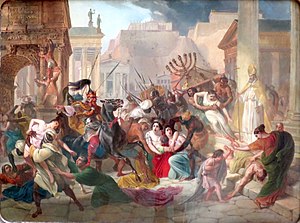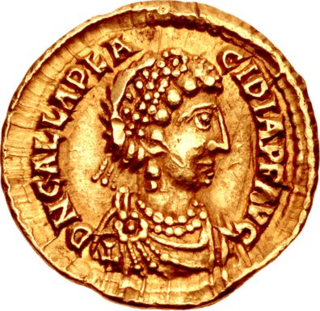
Galla Placidia, daughter of the Roman emperor Theodosius I, was a mother, tutor, and advisor to emperor Valentinian III. She was queen consort to Ataulf, king of the Visigoths from 414 until his death in 415, briefly empress consort to Constantius III in 421, and managed the government administration as a regent during the early reign of Valentinian III until her death.
The 430s decade ran from January 1, 430, to December 31, 439.
The 420s decade ran from January 1, 420, to December 31, 429.
The 450s decade ran from January 1, 450, to December 31, 459.

Year 439 (CDXXXIX) was a common year starting on Sunday of the Julian calendar. At the time, it was known as the Year of the Consulship of Theodosius and Festus. The denomination 439 for this year has been used since the early medieval period, when the Anno Domini calendar era became the prevalent method in Europe for naming years.
The 440s decade ran from January 1, 440, to December 31, 449.
The 460s decade ran from January 1, 460, to December 31, 469.
Year 449 (CDXLIX) was a common year starting on Saturday of the Julian calendar. At the time, it was known as the Year of the Consulship of Astyrius and Romanus. The denomination 449 for this year has been used since the early medieval period, when the Anno Domini calendar era became the prevalent method in Europe for naming years.

Anicius Olybrius was Roman emperor from July 472 until his death later that same year; his rule as Augustus in the western Roman Empire was not recognised as legitimate by the ruling Augustus in the eastern Roman Empire, Leo I. He was in reality a puppet ruler raised to power by Ricimer, the magister militum of Germanic descent, and was mainly interested in religion, while the actual power was held by Ricimer and his nephew Gundobad.
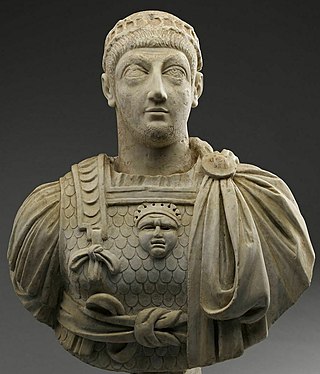
Valentinian III was Roman emperor in the West from 425 to 455. Made emperor in childhood, his reign over the Roman Empire was one of the longest, but was dominated by powerful generals vying for power amid civil wars and the invasions of Late antiquity's Migration Period, including the campaigns of Attila the Hun.
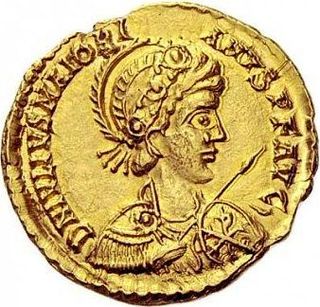
Majorian, was the Western Roman emperor from 457 to 461. A prominent commander in the Western military, Majorian deposed Avitus in 457 with the aid of his ally Ricimer. Possessing little more than Italy, Dalmatia, as well as some territory in Hispania and northern Gaul, Majorian campaigned rigorously for three years against the Empire's enemies. In 461, he was murdered at Dertona in a conspiracy, and his successors until the Fall of the Empire in 476 were puppets either of barbarian generals or the Eastern Roman court.
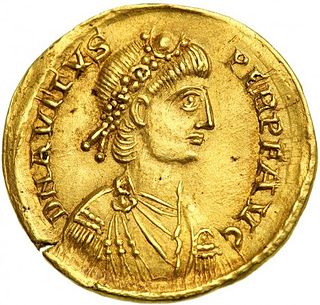
Eparchius Avitus was Roman emperor of the Western Empire from July 455 to October 456. He was a senator of Gallic extraction and a high-ranking officer both in the civil and military administration, as well as Bishop of Piacenza.

Petronius Maximus was Roman emperor of the West for two and a half months in 455. A wealthy senator and a prominent aristocrat, he was instrumental in the murders of the Western Roman magister militum, Aëtius, and the Western Roman emperor, Valentinian III.
Placidia was a daughter of Valentinian III, Roman emperor of the West from 425 to 455, and from 454/455 the wife of Olybrius, who became western Roman emperor in 472. She was one of the last imperial spouses in the Roman west, during the Fall of the Western Roman Empire during Late Antiquity.

Licinia Eudoxia was a Roman Empress, daughter of Eastern Roman Emperor Theodosius II. Her husbands included the Western Roman Emperors Valentinian III and Petronius Maximus.
Eudocia or Eudoxia was the eldest daughter of Roman emperor Valentinian III and his wife, Licinia Eudoxia. She was thus the granddaughter on her mother's side of Eastern emperor Theodosius II and his wife, the poet Aelia Eudocia; and on her father's side of Western emperor Constantius III and his wife Galla Placidia.

The sack of Rome in 455 AD marked a pivotal moment in European history when the Vandals, a Germanic tribe led by King Genseric, invaded the city. The Vandals pillaged the city for two weeks, causing widespread destruction. The event, following the Visigothic sack of 410, shocked the Roman world and symbolized the decline and impending fall of the Western Roman Empire.
Palladius was caesar of the Western Roman Empire for two months in 455. He was born between 415 and 425 AD and may have held the position of Praetorian Prefect during the 450's. After his father, Petronius Maximus, assassinated Emperor Valentinian III and seized power, Palladius became heir-apparent with the title of caesar. His marriage to Valentinian’s daughter Eudocia broke a pre-existing treaty in which Eudocia had been promised as a wife for Huneric, son of the Vandal king Genseric. The Vandals invaded and sacked Rome; while attempting to escape the city, Petronius Maximus and Palladius were killed by a mob of angry Romans on 31 May 455.
Gaiseric, also known as Geiseric or Genseric was king of the Vandals and Alans from 428 to 477. He ruled over a kingdom and played a key role in the decline of the Western Roman Empire during the 5th century.
Heraclius was an influential eunuch of the Western Roman Emperor Valentinian III.
